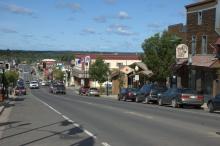Blandin Foundation Report Reveals Federally Subsidized Infrastructure in Minnesota Not Meeting Goals
The Connect America Fund provides annual federal funding to some of the largest telecommunications providers, but it can be hard for local officials to know where these dollars go.
A recent report digs deep into the federal subsidies for Internet service in Minnesota. Researcher Bill Coleman of Community Technology Advisors led a Blandin Foundation project that explored how federal Connect America Fund dollars have been used in two Minnesota telephone exchanges. In the end, researchers found that these networks would likely not meet Minnesota’s state connectivity goals.
Boots on the Ground
While digging through a paper trail of right-of-way agreements and local permits, researchers also went out into the field to find the actual infrastructure in the communities. They identified DSLAMs where fiber-optic lines connect to the copper DSL lines that run to people’s homes.
Using the locations of the DSLAMs, researchers mapped where people can likely receive federal government defined broadband of 25 Mbps download and 3 Mbps upload. The maps also show where people can likely get 10 Mbps download and 1 Mbps upload which is the standard for the Connect America Fund subsidy.
Result: Little Broadband Access
The 27-page report goes into detail on the connectivity available in the two telephone exchanges. The researchers conclude by explaining:
“In sum, CAF II investments in Minnesota are being spent to build networks that don’t meet today’s federal definition of broadband and won’t meet state goals for the future. Moreover, lack of transparency in proposed CAF II network plans and timelines is making it difficult for impacted communities to plan accordingly to ensure their broadband needs are being adequately met.“ (Page 22)



